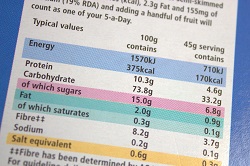Helping consumers to better understand health-related food package labelling
The project has aimed to determine how health-related claims and symbols on food packaging are understood by consumers, and how they impact on both purchasing and consumption trends. Encouraging consumers to buy healthier products is one way to improve diets, and health claims and symbols on food packaging are designed to help consumers make informed decisions. CLYMBOL revealed its comprehensive findings during its final conference in Brussels on Wednesday 15 June 2016. Use of claims on the European market CLYMBOL researchers began by looking at how often claims are used in Europe and discovered that 26 % of all food products carried at least one claim. Most of these claims were nutritional claims (64 %), followed by health claims (29 %), whilst only 6 % were health-related ingredient claims (referring to substances in a food product that are not nutrients but may have a nutritional or psychological effect, e.g. ‘contains one of your five a day.’) Data was collected in five different EU Member States (the UK, the Netherlands, Germany, Slovenia and Spain), with researchers buying 400 products per country from three types of store – a major national supermarket chain, a discount supermarket and a neighbourhood convenience store. The research team discovered that most products tended to have more than one claim per package, with several nutrition claims being often listed, for example ‘No sugar, low in calories’. Also, health claims were also accompanied by related nutritional claims, such as ‘high in calcium’ and ‘calcium is needed for the maintenance of healthy bones.’ Overall, the country with the most common symbolic claims was the Netherlands, whilst the UK was found to have the highest proportion of nutritional claims on its food packaging. How consumers respond to health claims The project found that several factors influence consumers’ trust, attitude and understanding of nutrition and health claims. People trust claims on food products when they are familiar with the nutrient or substance within the claim, and when the claim is relevant to their personal situation. On the other hand, claims with a lot of information were often unread by consumers and claims using overly scientific or regulatory language were found to be misunderstood by the vast majority of consumers. Overall, CLYMBOL found that consumers prefer short and easily comprehensible claims. As such, the project team has argued that communication with the consumer on health labelling should be kept simple but backed by scientifically sound evidence. An individual’s personal motivation was also very important on how much of an impact health-related claims had on their choice of food products. Individuals without a goal or motivation (such as buying food that is good for the heart) do not often choose food products with a health claim, whilst those that do have a specific health motivation are more likely to choose a product that claims to help fulfil their needs. The project researchers also discovered that even if a particular product used an image to highlight its health benefit, individuals without a goal or motivation were still not overly drawn towards choosing the product. A lively debate Following several presentations on the key CLYMBOL findings, the project conference also hosted a lively expert panel debate to further discuss the policy ramifications of the project’s results. Much of the debate focussed on the 2011 European Regulation on food labelling. Ms Olga Goulaki, from the European Commission, commented that after several years of the Regulation being in force, it was time for the Commission to review its implementation and whether it has contributed to improving public health. She also pointed out that the Regulation’s key focus was on ensuring consumers that claims on food packaging were both accurate and based on sound evidence, rather than encouraging better health choices. Dirk Jacobs, representing the industry association FoodDrinkEurope argued that the CLYMBOL results highlighted the need to improve health and nutritional literacy amongst the general population. He also argued that from an industry perspective, it was very difficult to communicate well with the general public under the current regulatory rules, such as when a particular product is reformulated and the manufacturer wishes to make new or additional health claims as a result. He continued by stating how important it is to look at the innovation potential of food labels, as well to ensure that consumers are not being misled. Finally, Prof. Rosalind Malcolm of the University of Surrey also questioned the impact of the Regulation in encouraging better public health. She argued that its key focus was to spur innovation, trade and fair competition. She questioned whether the Regulation, especially following the CLYMBOL findings, was the appropriate regulatory instrument for improving public health literacy through food labelling. The CLYMBOL project is now finishing its final project reports and will continue to work with the European Commission on the basis of its key results. The project is due to officially end in August 2016. For more information please see: project website
Countries
Belgium



